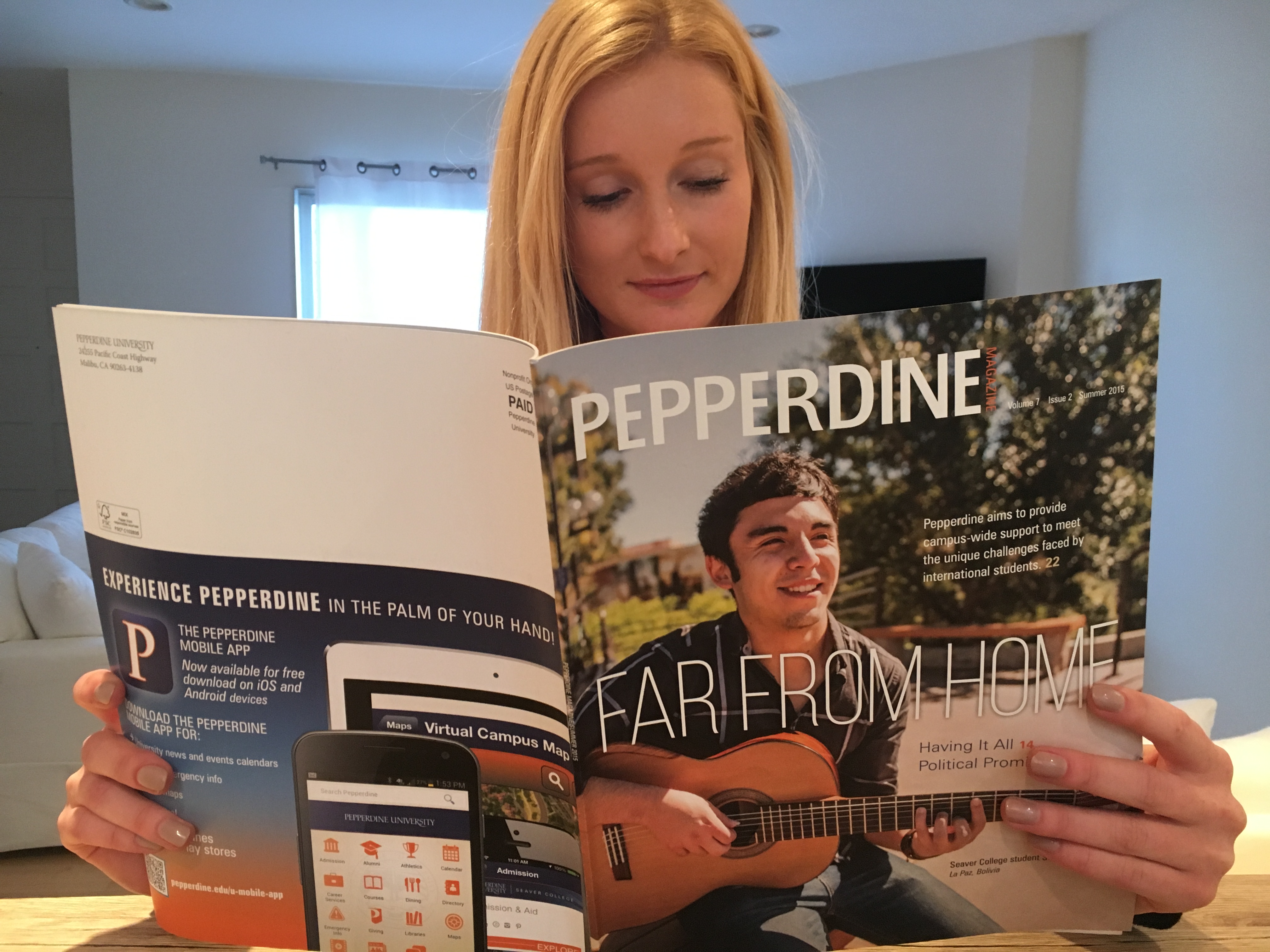
Maintaining Pepperdine’s image is not an easy task.
The Pepperdine brand encompasses five schools that speak to different audiences. Each school faces their own challenge to shine individually while maintaining one cohesive message as part of the larger university. Pepperdine’s marketing team strives to use a clear and consistent voice to communicate the university’s message of academic excellence and Christian values.
“The Pepperdine name is the single most valuable thing we possess,” said Rick Gibson, chief marketing officer and vice president for Public Affairs.
Pepperdine’s public affairs and marketing teams are responsible for creating and maintaining the reputation of five different schools. Targeted marketing efforts aim to attract the best fit student.
The Pepperdine name
The university brand is what comes to mind for someone when they hear the Pepperdine name. For Gibson, this includes clearly communicating Seaver’s Christian message and promoting Pepperdine as a nationally ranked university to keep Pepperdine in a competitive position. Marketing starts with promoting the brand and building Pepperdine’s reputation, Gibson said.
“I protect it, I promote it,” Gibson said.
Pepperdine draws students in through printed informational materials as well as digital experiences such as the university website. Marketing funnels a broad audience to the best-fit school based on interest, Gibson said.
“The brand has the role of really drawing people to the enterprise,” Gibson said.
A Pepp Post poll of 54 students found that about 90 percent first learned of Pepperdine through word of mouth. Only about 2 percent had first heard of Pepperdine through online advertisements.
The Pepp Post poll showed about 80 percent of students had a positive first impression from marketing materials before ever visiting campus.
Staying on brand
Each school has their own marketing department that aims to tell the Pepperdine story in a way that targets their perspective students. Marketing differs for Seaver College versus the Graziadio School of Business and Management, but they are both part of the larger Pepperdine brand.
Each school’s audiences differ by age, stage in life and interest.
Marketing to different audiences and not straying from the brand can be a challenge. The Graziadio school is shifting its message from Christian-based to value driven, Gibson said. If that message strays too much, people will question the brand.
Each school’s marketing team has the responsibility to promote and defend the individual brands, but most students make their decisions based on the larger Pepperdine brand, Gibson said.
How to market
The way to market five different Pepperdine schools is focusing on key publics, said Klive Oh, assistant professor of public relations.
Prior to his work as a professor, Oh was part of the overseas marketing team for Samsung Electronics in Korea.
When marketing different schools under the Pepperdine name, the key is to learn to speak to different audiences, “meet them at eye level of what their needs are,” Oh said.
Communicating a consistent mission is important in marketing, Oh said. The overall goal is to promote the Pepperdine brand and unique mission statement. Seeing the same message repeatedly enables audiences to deeply engage with ideas in the mission statement.
“People who are here actually get the opportunity to think about the mission,” Oh said. “That is an experience not a lot of schools provide.”
Seaver audiences
The main message of Seaver admissions to prospective students is focused on Christianity and academic excellence, said Kristy Collins, dean of Enrollment Management for Seaver College.
Reaching target audiences is all part of a coordinated marketing plan, Collins said. Marketing strategies include email outreach, social media, print materials, video campaigns and information sessions around campus. Pepperdine preview days let students see first-hand what campus life is like.
Pepperdine is able to track online activity through Constituent Relationship Management, or CRM Automation. CRM gathers information that shows marketing departments where individuals show interest online. This interest can be turned into action for a prospective student. Search Engine Optimization (SEO) allows Pepperdine to be searchable and visible online, Gibson said. These tools enable marketing departments to analyze data and target interested audiences.
Recruitment events such as campus tours and informational sessions on campus and around the country are an important part of marketing Pepperdine’s message. All events are highly scripted to make sure the message is the same across all audiences, Collins said. A scripted session ensures students all over the country are receiving the same message about Pepperdine.
The Graziado school
The Graziadio school has 17 programs whose target audience can be divided into full-time, part-time and executive-level students, said Amanda Karr, director of Enrollment Marketing for Graziadio.
Marketing for Graziadio promotes a value-centered mission. There is a leadership, social and ethical component to the program, Karr said.
“You have this responsibility you come out with,” Karr said. “You have a deeper respect for the business world and the world around you.”
Karr has the responsibility of marketing the school to the right student. One of her main goals is to make sure students feel like they made the right choice.
Expectations versus reality
For students to feel like they made the right choice, certain expectations need to be met. Pepperdine has to portray an accurate image while staying true to the brand that includes all five schools.
Ideally reputation and reality are at the same level, Gibson said. If reality falls too far behind reputation, this creates brand apathy, Gibson said.
“Pepperdine’s reputation is a step ahead of our reality,” Gibson said.
Marketing materials need to show an accurate depiction of what the Pepperdine brand stands for; a Christian mission and academic excellence.
The Pepp Post poll found that half of students surveyed think Pepperdine’s marketing contains some mixed messages. Some 40 percent of students believe Pepperdine is portrayed in marketing materials exactly how it actually is.
The above chart shows how students feel about the clarity of Pepperdine’s Christian message, based on a Pepp Post poll of 54 students.
Clearly Christian
Connie Horton, vice president for Student Affairs, said Pepperdine is working hard to be clear about the unique university Pepperdine is, being one that combines academic rigor with a Christian mission. Horton said faculty needs to be comfortable articulating what the Pepperdine experience looks like for students.
“We get into trouble when we’re not really clear about this is who we intend to be,” Horton said.
Horton has heard a wide variety of feedback from students about the reality of Pepperdine’s Christian culture. Some students think there is a stronger presence of Christianity on campus than they expected, while others think the community falls short of their expectations. Horton said some students feel like Pepperdine does not meet the “hype” or stereotype it portrays.
Pepperdine’s Office of Church Relations actively works to maintain the university’s heritage with the Churches of Christ by recruiting students, Church Relations Manager Tami Williamson. Won by One is a six-member acapella group of Pepperdine undergraduate students, which travels all over the country to recruit students as well as build relationships with churches.
Associated Women for Pepperdine is an organization that provides scholarship money to students with a Church of Christ heritage. About 10 to 15 entering students will receive a $5,000 scholarship, Williamson said. This is a key way to market specifically to Churches of Christ.
Reputation from students
Senior advertising major Mackenzie Aycock has a high regard for Pepperdine’s reputation. Touring Pepperdine gave Aycock a sense of the Christian community at Pepperdine, but she found the university is affiliated with the Churches of Christ through her own research. She was aware of the academic rigor, but not aware of Convocation requirements. She thinks Pepperdine can take advantage of more social media platforms to clearly communicate the Pepperdine brand.
“We have really strong videos that are brilliantly done,” said Julia Sumouske, senior public relations major and vice president of marketing for the Student Alumni Association. She praised the way Pepperdine uses visuals to promote the brand.
“Facebook is our biggest ally,” Sumouske said.
Facebook can reach the largest audience for a broad message. Instagram, Twitter, and traditional email advertisements are still used to market the organization. As a prospective Pepperdine student, Sumouske said she looked to reviews and message boards to get an idea of what Pepperdine life was like.
“We target young adults that lead a life full of service and leadership,” Sumouske said.
Reputation in Malibu
Being raised in Malibu, Gianna Grasska, junior business administration major, has always been familiar with Pepperdine’s academic rigor and faith-based education. But she was not aware Pepperdine was affiliated with the Churches of Christ. Grasska did not think any Christian message was communicated for the other four Pepperdine schools.
Seaver and other Pepperdine schools have always had a strong reputation to the Malibu community, Grasska said.
“If you said ‘Pepperdine,’ you always got a great response,” Grasska said.
Anna Milton completed the reporting for this story under the supervision of Dr. Christina Littlefield and Dr. Theresa de los Santos in Jour 241 in fall 2017. Dr. Littlefield supervised the writing of the web story.



